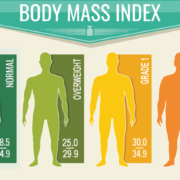Body Roundness Index
The Body Mass Index (BMI) has been used to provide an indication of whether someone is under weight, normal weight, overweight, or obese and the degree to which they are obese. There’s no measure of percentage of body fatness implied, but physicians and other medical professionals have used it for that purpose for a couple of decades. Why? It can be used to assess the potential risk of developing cardiovascular disease, pre-diabetes, and other metabolic conditions.
I happened upon a commentary in JAMA on the Body Roundness Index or BRI for short. It was published in response to a recent study published in a JAMA Network Open by researchers who examined the relationship between BRI and mortality.
Let’s start with this: what is the BRI? The BRI was developed by a mathematician. The reason was interesting; the developer told the commentator that the BMI is based on a “cylindrical” model but when she looked in the mirror, she felt she was more egg shaped. What she did, as a mathematician, was develop a model based on an “ellipse.” Why? She gave a couple of reasons.
The first reason is that BMI can misclassify individuals because it fails to distinguish between individual amounts of fat-free mass (FFM) and fat mass (FM). BMI also does not provide information about the distribution of body fat—specifically, visceral fat versus subcutaneous fat. She developed a mathematical model, to assess body fatness which would indicate where the fat is distributed. With some very complicated math, she developed the BRI. It uses only two measurements: height and waist circumference. The benefit of using the BRI is that it may be a better predictor of body fat than the BMI. Is it? We’ll check out the research study that began this examination of BRI on Saturday, because as Shaq famously said about getting in shape, “Round is a shape.”
The Insider Conference Call is tomorrow night. If you become an Insider by 8 p.m., you can participate in the call to get your questions answered.
What are you prepared to do today?
Dr. Chet
References:
1. JAMA. 2024; 332(16):1317-1318. 10.1001/jama.2024.20115
2. JAMA Netw Open. 2024; 7(6):e2415051. 10.1001/jamanetworkopen.2024.15051.
3. https://doi.org/10.1002/oby.20408









